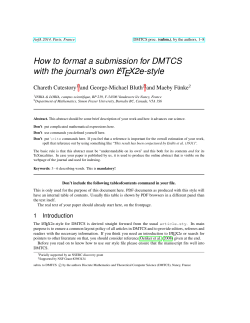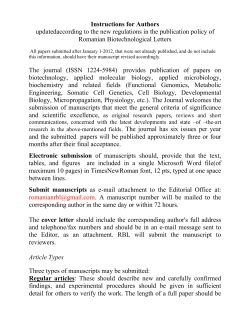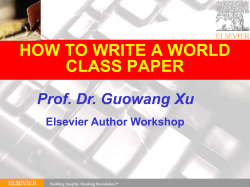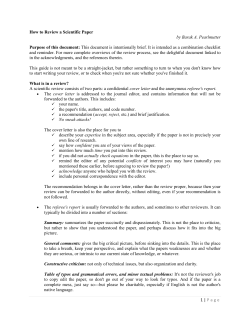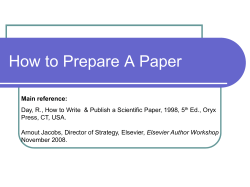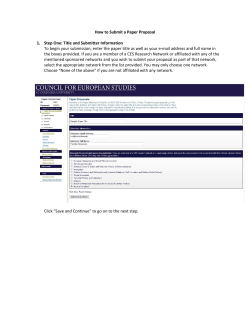
How to disseminate your research results: Essentials of effective publishing Prepared by
How to disseminate your research results: Essentials of effective publishing SMC CLS FuJen Catholic University, Taiwan, 14 April 2014 Prepared by Witold Pedrycz, PhD, DSci, Fellow (IEEE) University of Alberta, Edmonton, Canada, and Systems Research Institute, Polish Academy of Sciences, Warsaw, Poland Presented by Daniel Yeung South China University of Technology, Guangzhou, China Agenda •Writing a quality manuscript •Preparation •Constructing the paper •Language •Technical details •Revisions and response to reviewers •Ethical issues •Conclusions Preparation Originality Key objectives Nature of study (fundamental, experimental, case study, etc.) Possible submission vis-à-vis scope of journal and potential impact of work Article structure • • • • • Title Authors Abstract Keywords Main text – – – – Need to be accurate and informative for effective indexing and searching Introduction Methods Results Discussion (Conclusion) • Acknowledgements • References • Supplementary material (optional) Each has a distinct function Title A good title should contain the fewest possible words that adequately describe the contents of a paper DO Convey main findings of research Be specific Be concise Be complete Attract readers Title A good title should contain the fewest possible words that adequately describe the contents of a paper DON’T Use unnecessary jargon Use uncommon abbreviations Use ambiguous terms Use unnecessary detail Focus on part of the content only Title Slower learning in multilayer neural networks is correlated with numerous inputs of diversified ranges, high level of noise, and nonstationary nature of data Relationships between data preprocessing and learning in multilayer neural networks Authors and affiliations Be consistent with spelling, full versus short names, full versus short addresses Surnames: Middle Initial: Use consistently or not at all First Names: e.g., Mike/ Michael Affiliation: Abstract The quality of an abstract strongly impacts the editor’s decision A good abstract: •Is precise and honest •Stand alone entity •Uses no technical jargon •Is brief and specific •Cites no references Keywords Keywords are important for indexing: they enable your manuscript to be more easily identified and cited Check the Guide for Authors for journal requirements •Keywords should be specific •Keep the number of keywords small •Avoid uncommon abbreviations and general terms Introduction Provide the necessary background information to put your work into context It should be clear from the introduction: •Why the current work was performed –aims –significance •What has been done before •What was done (in brief terms) •What was achieved (in brief terms) Introduction DO •Consult the Guide for Authors for word limit •“Set the scene” •Outline “the problem” and hypotheses •Ensure that the literature cited is balanced, up to date and relevant •Define any non-standard abbreviations and jargon Introduction DON’T •Write an extensive review of the field •Cite disproportionately your own work, work of colleagues or work that supports your findings while ignoring contradictory studies or work by competitors •Describe methods, results or conclusions other than to outline what was done and achieved in the final paragraph •Overuse terms like “novel” , “highly original” and “for the first time” Mathematics •Avoid “dry” formulas; explain them •Explain all symbols before using them •Avoid misuse of symbols •Use standard notation (say, vectors) Results The main findings of the research DO •Use figures and tables to summarize data •Show the results of statistical analysis •Compare “like with like” Results The main findings of the research DON’T •Duplicate data among tables, figures and text •Use graphics to illustrate data that can easily be summarized with text Graphics Figures and tables are the most effective way to present results BUT: •Captions should be able to stand alone, such that the figures and tables are understandable without the need to read the entire manuscript •The data represented should be easy to interpret •Colours should only be used when necessary; not to be overused Graphics Illustrations should only be used to present essential data The information in the table can be presented in one sentence: ‘The surface soils were dark grayish brown, grading to light olive brown (woodland), dark grayish brown (wetland), and pale olive (grassland) at 100 cm.’ Summarize results in the text where possible Graphics The figure and table show the same information, but the table is more direct and clear ECOLOGICAL GROUP Station I II III IV V 75U 75R 200R 500R 1000R 91.3 89.8 69.3 63.0 86.7 5.3 6.1 14.2 29.5 8.5 3.2 3.6 8.6 3.4 4.5 0.2 0.5 6.8 4.2 0.2 0.0 0.0 1.1 0.0 0.0 Graphics •Legend is poorly defined •Graph contains too much data •No trend lines Graphics •Legend is well defined but there is still too much data and no trendlines Graphics •Legend is clear •Data is better organized •Trend lines are present Discussion Describe •How the results relate to the study’s aims and hypotheses •How the findings relate to those of other studies •All possible interpretations of your findings •Limitations of the study Discussion Avoid •Making “grand statements” that are not supported by the data Example: “This novel optimization method will enormously reduce the learning time” •Introducing new results or terms Conclusion Put your study into CONTEXT Describe how it represents an advance in the field Suggest future works BUT Avoid repetition with other sections Avoid being overly speculative Do not over-emphasize the impact of your study Acknowledgements Acknowledge anyone who has helped you with the study, including: •Researchers who supplied materials or software, • •Anyone who helped with the writing or English, or offered critical comments about the content •Anyone who provided technical help State why people have been acknowledged and ask their permission Acknowledge sources of funding, including any grant or reference numbers References Check the Guide for Authors for the correct format Check •Spelling of author names •Punctuation •Number of authors to include before using “et al.” •Reference style References Check the Guide for Authors for the correct format Avoid •Personal communications, unpublished observations and submitted manuscripts not yet accepted •Outdated papers •Citing articles published only in the local language •Excessive self-citation and journal self-citation References Check the style and format as required – it is not the editor’s job to do so for you Harvard System (alphabetical by author/date) APA (American Psychological Association) System (alphabetical) Vancouver System (numbered in order or citation) Note: there are a number of other systems in use and variations for all systems Supplementary material Information related to and supportive of the main text, but of secondary importance •Data •Code •Video data Will be made available online when the manuscript is published The three “C”s (C3) principle Good writing possesses the following three “C”s: •Clarity •Conciseness •Correctness (accuracy) The key is to be as brief and specific as possible without omitting essential details Common traps Good writing avoids the following traps: •Repetition •Redundancy •Ambiguity •Exaggeration These are common annoyances for editors Repetition and redundancy Vary the sentences used when writing the abstract or describing findings at the end of the introduction Don’t copy from other sections verbatim! Avoid words with the same meaning In addition, there were also modifications to the learning rule dealing with… Ambiguity Compare apples to apples… The results produced by the fuzzy model are compared with several neural networks The results produced by the fuzzy model are compared with those produced by several neural networks Exaggeration Effect of p.o. administration of tea and caffeine on tumor number Tumor number 60 * 50 40 30 20 10 0 Water Green Tea Black Tea Caffeine Treatment “There was a massive decrease in the number of tumors following p.o. administration of green tea” Beware of exaggeration but do indicate significance Other common traps Incorrect use of etc. / and so on “The two groups of data were compared using a variety of statistical methods including a t-test, chi squared analysis, etc.” It is important here to define the tests used as they are particular to the paper, not part of a natural series and not obvious to the reader Language Editing Services Your manuscript is precious, invest in it • Specialist scientific and engineering editing services are commercially available to polish the language in your manuscript prior to journal submission Layout •Keep line spacing, font and font size consistent throughout – double-spaced 12-point Times New Roman is preferred •Use consistent heading styles throughout and no more than three levels of heading •Number the pages •Number lines if journal requires – check the Guide for Authors •Order and title sections as instructed in the Guide for Authors – Figure and Table sections are normally together following References Length Consult the Guide for Authors for word and graphic limits Check available categories: full paper, brief paper, communication Letters or short communications have stricter limits on the length. For example, 3,000 words with no more than five illustrations. Abbreviations • Define non-standard abbreviations on first use in both the abstract and the main text • Check the Guide for Authors for a list of standard abbreviations that don’t need defining • Don’t abbreviate terms used only once or twice in the entire manuscript – spell these out in full • Acronyms: capitals not required in the definition unless a proper noun or start of a sentence Cover letter • This is your chance to speak to the editor directly • Keep it brief, but convey the particular importance of your manuscript to the journal • Suggest potential reviewers This is your opportunity to convince the journal editor that they should publish your study, so it is worth investing time at this stage Revisions and Response to Reviewers Final checks Revision before submission can prevent early rejection What can I do to ensure my paper is in the best possible state prior to submission? •Ask colleagues to take a look and be critical •Check that everything meets the requirements set out in the Guide for Authors – again! •Check that the scope of the paper is appropriate for the selected journal – change journal rather than submit inappropriately Final checks Revision before submission can prevent early rejection What can I do to ensure my paper is in the best possible state prior to submission? •If necessary, get a colleague or approved editing service to improve the language and ensure that the manuscript adheres to the requirements •Ensure that the literature cited is balanced and that the aims and purpose of the study, and the significance of the results, are clear •Use a spellchecker Manuscript submission: milestones decision decision review submission review submission submission of revision of final version Post-referee revision Carefully study the reviewers’ comments and prepare a detailed letter of response •Respond to all points; even if you disagree with a reviewer, provide a polite, scientifically solid rebuttal rather than ignore their comment •Provide page and line numbers when referring to revisions made in the manuscript •Perform additional calculations, computations, or experiments if required; these usually serve to make the final paper stronger Post-referee revision The reviewer is clearly ignorant of the work of …. Thank you for your comment. However, we feel that the assumption in our model is supported by recent work by … Post-referee revision •State specifically what changes you have made to address the reviewers’ comments, mentioning the page and line numbers where changes have been made •Avoid repeating the same response over and over; if a similar comment is made by multiple people explain your position once and refer back to your earlier response in responses to other reviewers or the editor Accepting rejection Don’t take it personally! •Try to understand why the paper has been rejected •Evaluate honestly – will your paper meet the journal’s requirements with the addition of more data or is another journal more appropriate? •Don’t resubmit elsewhere without significant revisions addressing the reasons for rejection and checking the new Guide for Authors Accepting rejection •Suggested strategy for submitting elsewhere: •In your cover letter, declare that the paper was rejected and name the journal •Include the referees’ reports and show how each comment has been addressed •Explain why you are submitting the paper to this journal; is there a more appropriate journal? Ethical Issues Ethical Issues http://www.ieee.org/web/publications/rights/p lagiarism_FAQ.html Unethical behavior includes: •Multiple submissions •Redundant publications •Plagiarism •Data fabrication and falsification •Improper use of human subjects and animals in research •Improper author contribution Multiple submissions Multiple submissions save your time but waste editors’ The editorial process of your manuscripts will be completely stopped if the duplicated submissions are discovered Multiple submissions Competing journals constantly exchange information on suspicious papers You should not send your manuscripts to a second journal UNTIL you receive the final decision from the first journal DON’T DO IT!! Redundant publication An author should not submit for consideration in another journal a previously published paper •Published studies do not need to be repeated unless further confirmation is required •Previous publication of an abstract during the proceedings of conferences may not preclude subsequent submission for publication, but full disclosure should be made at the time of submission Plagiarism “Plagiarism is the appropriation of another person’s ideas, processes, results, or words without giving appropriate credit, including those obtained through confidential review of others’ research proposals and manuscripts” Federal Office of Science and Technology Policy, 1999 Plagiarism Plagiarism is a serious offence that could lead to paper rejection, academic charges and termination of employment. It will seriously affect your scientific reputation DON’T DO IT! Plagiarism-levels Uncredited verbatim copying of a full paper or verbatim copying within more than one paper by the same author(s) Uncredited verbatim copying of large portion (20-50%) or verbatim copying within more than one paper by the same author(s) Uncredited verbatim copying of individual elements (paragraphs, sentences, illustrations) resulting in a significant portion (up to 20%) within a paper Uncredited improper paraphrasing of pages or paragraphs Credited verbatim copying of a major portion of a paper without clear delineation (quotes or indents) Data fabrication and falsification • Fabrication is making up data or results, and recording or reporting them • Falsification is manipulating research materials, equipment, processes; or changing / omitting data or results such that the research is not accurately represented in the research record Unethical research • Experiments on human subjects or animals should follow related ethical standards, namely, the Helsinki Declaration of 1975, as revised in 2000 (5) • If doubt exists concerning the compliance of the research with the Helsinki Declaration, authors must explain the rationale for their approach and demonstrate approval from the institutional review body Conclusion: Getting Accepted
© Copyright 2025







